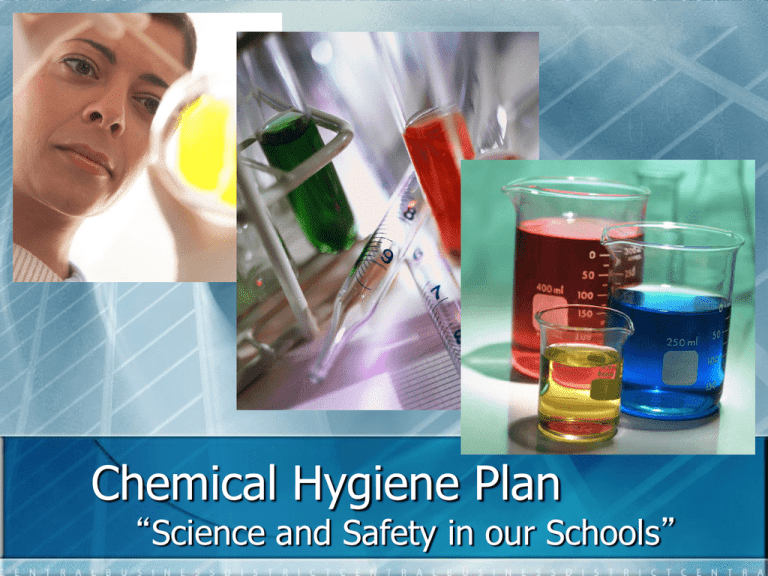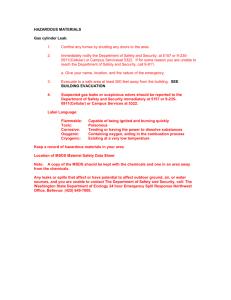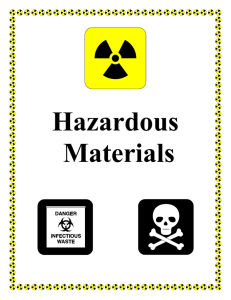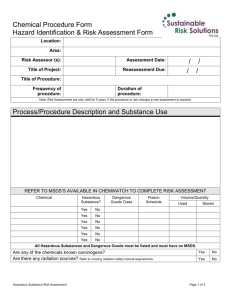Chemical Hygiene Plan
advertisement

Chemical Hygiene Plan “Science and Safety in our Schools” Establishment of the Chemical Hygiene Plan Arkansas Act 556 of 1991 mandates that all business’s, industry, and educational facilities that handle chemicals that might be deemed hazardous and dangerous to health must provide public employees access to training and information concerning hazardous chemicals OSHA - commonly known as the “right to know” law. We recognize the importance of providing a save environment for students and employees. Components required for “Right to Know” law. Material Safety Data Sheets (MSDS); Hazardous Materials List; Inventory; Notification of employee as to hazard; Training; Labeling of Hazardous Materials; Chemical Hygiene Plan and Officer (New Laboratory Standard passed in 1991). Five Major Steps to Compliance Inventory and compile a list of all chemical hazards; Acquire, update and maintain all Material Safety Data Sheets (MSDS); Label all containers properly; Train (students and employee’s); Develop a Chemical Hygiene Plan (CHP) Chemical Hygiene Officer Responsible for monitoring the Chemical Hygiene Plan at the district or school level. Be responsible for disseminating all information involving chemical safety at the school. Responsible for being the contact person involving chemical safety for the school. Inspects labs and storage areas annually. Monitors science and chemical inventories and safety devices. MSDS Must be in English; Must contain the chemical name and all hazardous components, Health hazards listed, Applicable precautions, Name and address of the MSDS supplier, First aid procedures. Hazardous Materials Sodium and Chlorine Mixture Dust Explosion B. Baking Flour • Lycopodium Powder C. Sawdust D. Vapor from ethanol, methanol and other flammables E. Coffee mate F. Iron filings Common Lab Materials Sulfuric Acid White Phosphorus Over the Counter Materials Common Hazardous items in Schools and available to students Ammonia and Chlorine mixture, Methanol, Dry Ice, Soda and Swimming pool chlorine, Drano and gasoline, Fertilizer and gasoline, Carbide, Aerosol cans. Maintenance and Custodial Hazards Disposal of Gasoline, paint, pesticides and petroleum based cleaners, is federally and state regulated. Our Labs The “Perfect” School District Texas A/M University, Chemistry Lab Ohio State University Chemistry Lab Fire Public Schools Experts expect schools and universities have 100 to 1000 more accidents than occur in chemical plants such as Dow and others, most unreported, A survey of 60 schools in Iowa revealed 1,500 containers of haz-mat, 150 students seriously injured nationwide in the past four years, 70% of lab accidents occurred in the 9th grade (Duff, 1996). Haz-Mat Removal A. Extremely expensive, B. Often involves Mercury, heavy metals, or asbestos in academia. Hazardous Materials List Each school should have compiled a list of all materials deemed hazardous and include the locations where the materials are located, This list should be available to all employees, Employees should be advised of safety factors concerning the handling and use of all materials listed. This should be updated annually. Local fire department should be alerted as to location of hazardous materials. Inventory Make out an alphabetized list of the chemicals you have available; Update this list on each time an order is placed or material is used; All chemical orders should be initialed by the Chemical Hygiene Officer, Custodial staff should keep a record of supplies. Obtain a list of common chemicals from Flinn (website) or other chemical supplies and check off those you have; Training Learn to read and understand MSDS; Provide location of Hazardous materials; Learn both chronic and acute hazards associated with work place; Handle chemicals safely; Require protective equipment; First aid and emergency procedures in case of emergency. Standard Equipment Fire Extinguisher Eye Hand Protection Vent hood Eye Wash Station Labeling of all Hazardous Materials Name of chemical and date; A list (MSDS) containing hazards; Name and address of Manufacturer. Chemical Hygiene Plan High School will have copies of the plan, the chemical inventory, and the MSDS in the main office and in the chemical storage area; Each science teacher and maintenance employee will be given a copy; Students and Science curriculum guide will contain pertinent information from the CHP. Enjoy Science Safely!




